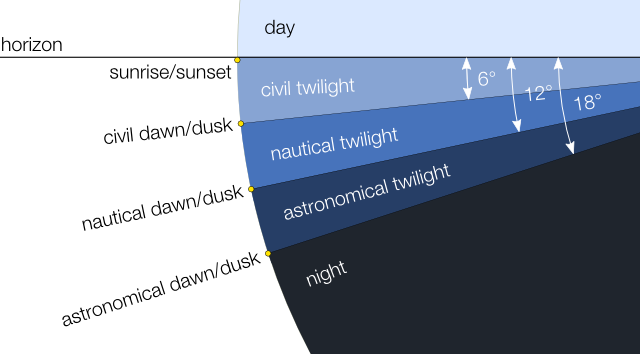Dawn occurs before sunrise, before the top of the Sun reaches the horizon. Astronomical Dawn is the point at which it becomes possible to detect light in the sky, when the sun is 18° below the horizon. Nautical Dawn occurs at 12° below the horizon, when it becomes possible to see the horizon properly and distinguish some objects. Civil Dawn occurs when the sun is 6° below the horizon and there is enough light for activities to take place without artificial lighting.
Dusk occurs after sunset, once the top of the Sun has passed the horizon. As with dawn there is astronomical dusk, nautical dusk and civil dusk, occurring at 18°, 12° and 6° below the horizon respectively.
Twilight is the name given to the period between dawn and sunrise, or between sunset and dusk, when light is still visible in the sky due to sunlight scattering off the atmosphere. It can also be separated in astronomical, nautical and civil sections by how far below the horizon the Sun is.

Sunrise and sunset are the points at which the top edge of the Sun reaches the horizon; the only difference between them is the direction in which the Sun is moving at the time. It actually occurs when the top of the Sun is 0.57° below the horizon due to refraction of the Sun’s light by the atmosphere.
Guys dont be confused, it is very simple.
Dawn: time before sunrise when sky reddish
Dusk: time after sunset when sky reddish
Twilight: actually reddish light in dusk or dawn
yes, but what is the time period called that resides between daylight and dark??
Dusk
What is eventide?
“Eventide” just means evening.
Thanks a lot for such easy explanation
Love this explanation with the visual. It was easy to understand thanks to you!
Dawn, or first light is 30 minutes before sunrise. So dusk is 30 minutes after sunset.
Nope.
Is there a constant or average number of minutes for the number of twilight minutes?
It varies.
Can you drive without headlights when it is dawn, 30 min before sunrise?
I wouldn’t, Myra.